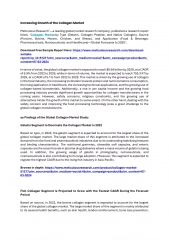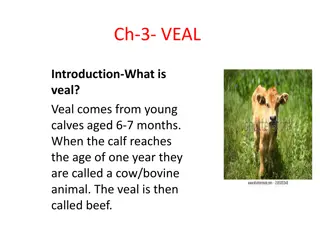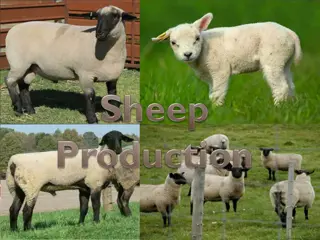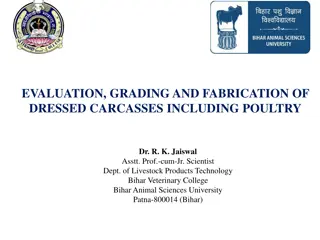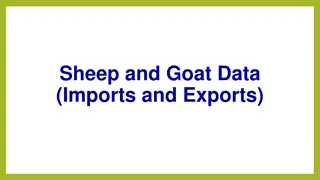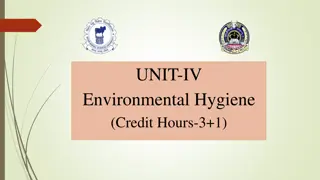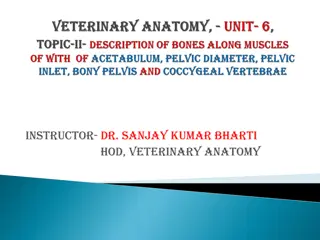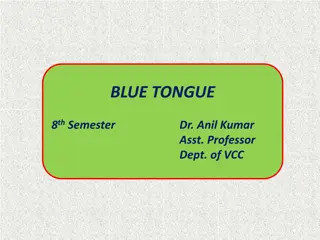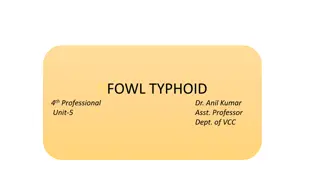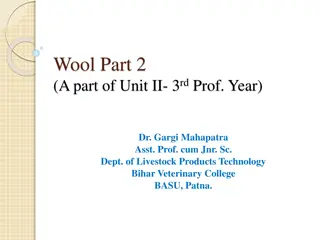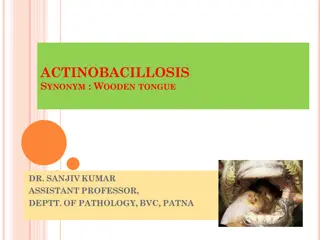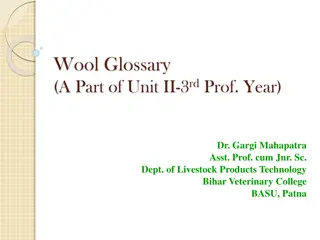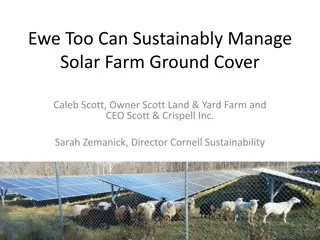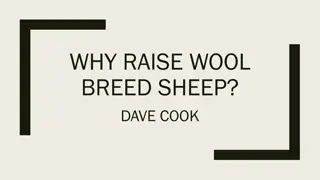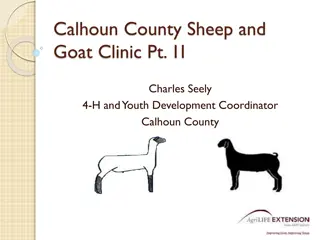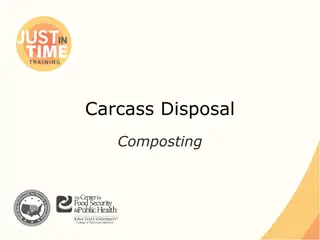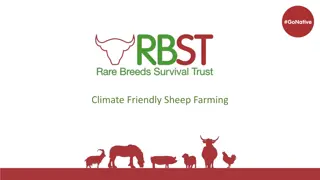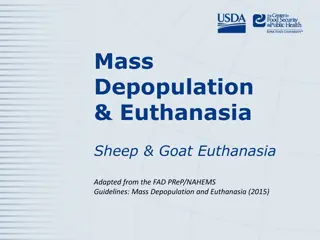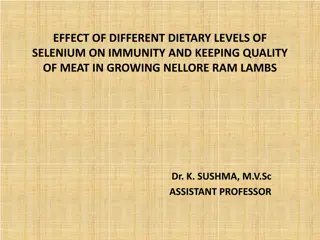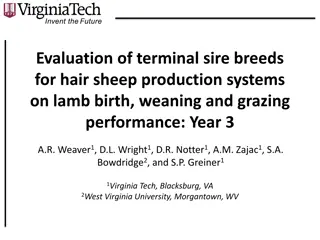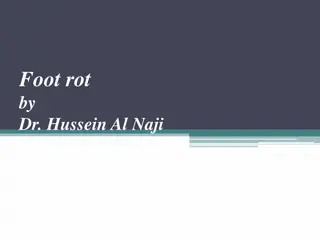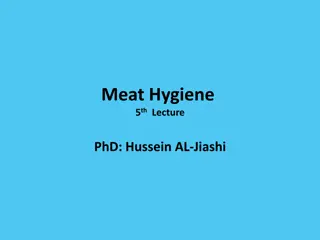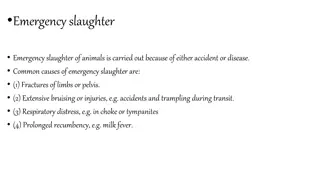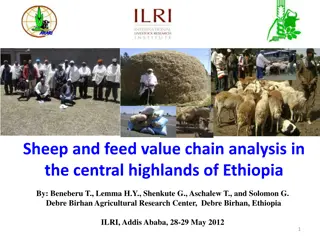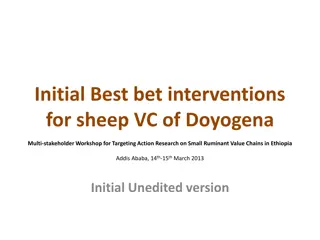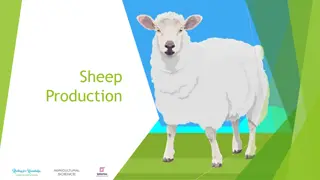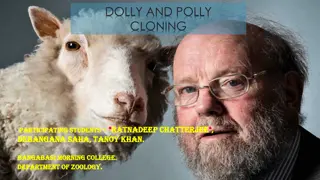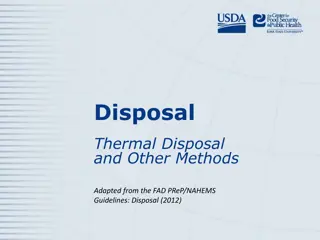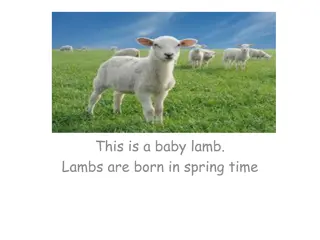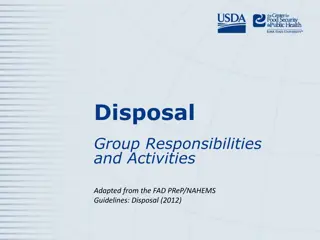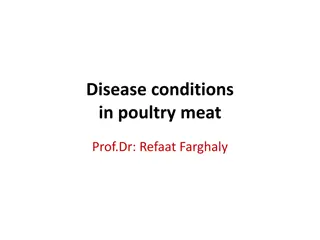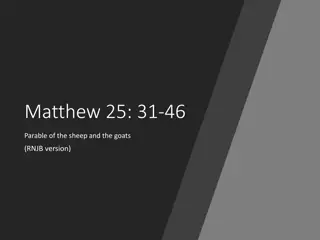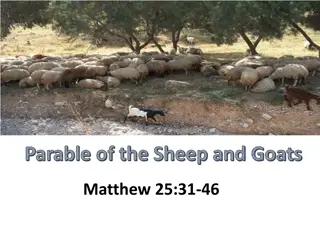Collagen Market
Collagen Market by Type (Gelatin, Collagen Peptide, and Native Collagen), Source (Porcine, Bovine, Marine, Chicken, and Sheep), and Application (Food & Beverage, Pharmaceuticals, Nutraceuticals, and Healthcare) - Global Forecasts to 2029
0 views • 2 slides
Understanding Veal: Types, Characteristics, Grading, and Cooking Methods
Veal is a tender meat sourced from young calves aged 6-7 months. It has a light color, fine texture, and smooth taste. Learn about different types of veal such as Bob Veal and Special-Fed Veal, as well as the grading system for veal carcasses. Discover the various cuts of veal and explore recommende
1 views • 9 slides
Sheep Farming Essentials: Terminology, Breeds, and Practices
Explore the fundamental aspects of sheep farming including terminology, breeds like Merino and Rambouillet, and essential practices such as lambing, fleece collection, and managing a flock. Understand key concepts like prolificacy and fine wool production in this comprehensive guide to sheep husband
0 views • 74 slides
Overview of Carcass Evaluation and Grading in Livestock Processing
Carcass evaluation and grading are vital processes in the marketing and merchandizing of livestock carcasses. Dr. R. K. Jaiswal, a knowledgeable Asstt. Prof.-cum-Jr. Scientist, delves into the significance of evaluation, dressing percent, carcass length, back fat thickness, ribbing, loin eye area, a
1 views • 24 slides
Insights on Sheep and Goat Data Trends: Imports, Exports, and Prices
Explore the changing dynamics of sheep and goat data trends in the market focusing on imports, exports, price movements, and volume changes. Discover the impact of frozen bone-in cuts, fluctuating prices, and key suppliers like New Zealand. While sheep meat imports have fluctuated, goat meat imports
0 views • 19 slides
Ensuring Hygienic Disposal of Carcasses and Fallen Animals
Disposing of carcasses and fallen animals is a crucial responsibility for veterinarians to maintain environmental hygiene and prevent health risks. Improper disposal can lead to the spread of diseases and attract pests. Various methods, such as burial, cremation, and incineration, are used to ensure
0 views • 22 slides
Overview of Livestock Production: Cattle, Sheep, and Goat Breeds
Explore the diverse world of livestock production, including cattle ranching, dairy farming, hog and pig farming, poultry and egg production, and animal aquaculture. Delve into the specifics of sheep and goat production, from breeds and production systems to management practices, breeding techniques
1 views • 43 slides
Veterinary Anatomy Overview: Pelvic Cavity and Bony Pelvis Structures
The instructor, Dr. Sanjay Kumar Bharti, explains the acetabulum, obturator foramen, sexual differences, and characteristics of sheep and goats related to pelvic anatomy. Details include the structure of the acetabulum, the large obturator foramen, pelvic cavity, and differences between male and fem
2 views • 18 slides
Understanding Bluetongue Disease in Sheep, Cattle, and Goats: Causes, Symptoms, and Diagnosis
Bluetongue disease is a viral illness predominantly affecting sheep, with occasional cases in cattle and goats. Transmitted by insect vectors, it can lead to various symptoms such as catarrhal stomatitis, lameness, and reproductive issues. The disease's impact, transmission methods, clinical signs,
0 views • 8 slides
Understanding Fowl Typhoid: Causes, Transmission, Clinical Signs, and Control Measures
Fowl typhoid, caused by Salmonella gallinarum, affects adult chickens with high mortality rates. It spreads through infected droppings, carcasses, and fomites. Clinical signs include listlessness, diarrhea, and organ swelling. Diagnosis involves isolation and identification, while treatment options
0 views • 4 slides
Development of Wool Follicles in Sheep: A Detailed Overview
Wool production in sheep involves the development of wool follicles starting from the basal layer of the epidermis. The process includes the formation of follicles during gestation, thickening of the basal layer into a plug, growth of accessory structures like glands, and the differentiation of cell
0 views • 17 slides
Exploring Local Wisdom in Garut for Sheep Care
Ethnopedagogical studies in Garut reveal the significance of local wisdom in caring for sheep, emphasizing cultural values and societal behavior. The research focuses on the Padepokan Cantik Group in Leles District, exploring the concept of caring for Garut sheep and the importance of preserving loc
1 views • 11 slides
Valais Blacknose Sheep Washing Tips for Show preparation
Learn valuable tips for washing your Valais Blacknose sheep to get them show-ready, including grooming tools, recommended items, washing process, and how to aim for the desired fleece quality. These tips will help you present your sheep in the best possible way for competitions or exhibitions.
0 views • 6 slides
Actinobacillosis (Wooden Tongue) in Cattle and Sheep: Overview of the Infectious Disease
Actinobacillosis, also known as Wooden Tongue, is a specific infectious disease affecting cattle and sheep, caused by Actinobacillus lignieresii. It is characterized by fibrosis of the tongue and soft tissues, leading to mobility issues. The disease is primarily transmitted through wounds and abrasi
0 views • 8 slides
Opportunities for Scaling up Bovine Meat Exports in Pakistan
Pakistan's bovine meat export sector has potential for growth, with a focus on chilled bovine meat. The country currently holds a limited share in the global market, exporting mainly to GCC countries, Afghanistan, and Vietnam. Within the GCC market, Pakistan has significant market share in both chil
0 views • 21 slides
Understanding Fowl Cholera in Birds: Causes, Symptoms, and Management
Fowl cholera, a septicaemic disease affecting birds, is caused by Pasteurella multocida. It can affect all species of birds, with older birds more susceptible. The disease can spread through carrier birds, excretions, carcasses, and even rats. The virulence factors, clinical signs, and forms of the
2 views • 9 slides
Understanding Wool: A Comprehensive Glossary of Terminology in Sheep Wool Production
Dive into the world of sheep wool production with this detailed glossary covering essential terms such as fleece, lock, greasy wool, kemp, keratin, crimp, staple length, suint, lanolin, burr, scouring, carbonization, shearing, and more. Explore the nuances of wool processing, from fiber characterist
0 views • 8 slides
Sustainable Management of Solar Farm Ground with Sheep
Utilizing sheep to manage vegetation at solar farms can reduce maintenance costs, carbon footprint, and reliance on herbicides. The natural grazing of sheep promotes a healthy ecosystem, stimulates the local economy, and provides a sustainable solution for solar farm ground cover.
0 views • 14 slides
Raising Wool Breed Sheep: Why It Matters in Showing and Selling
Discover the significance of raising wool breed sheep, including the benefits of high-quality wool, the importance of wool quality in show placements, and how judges evaluate fleece quality in competitions. Explore the competitive edge, ease of handling, and less competition compared to meat breeds.
1 views • 28 slides
Sheep and Goat Clinic: Feeding, Exercising, and Show Preparation Tips
Topics covered in the Sheep and Goat Clinic include feeding strategies (last 90 days), the importance of balancing fat levels, exercising routines leading up to show day, and final points on feeding and fat management. The images provide valuable insights on feeding athletes, understanding fat level
0 views • 20 slides
Effective Carcass Disposal Through Composting
Composting carcasses with organic materials can accelerate biological decomposition, destroy pathogens, and produce a nutrient-rich humus. Proper carbon-to-nitrogen ratios, moisture levels, oxygen maintenance, and temperature control are crucial for the efficiency of the composting process. Mixing a
0 views • 21 slides
Protect Your Sheep: Preventing Diseases and Ensuring Animal Health
Learn how to protect your flock of sheep from diseases that harm animal health and can be costly. Take steps today to keep diseases out by following biosecurity measures. This material was developed with a grant from USDA to promote sheep biosecurity.
0 views • 5 slides
Understanding Climate-Friendly Sheep Farming in the UK
UK sheep farming plays a vital role economically, environmentally, and culturally. The industry faces challenges with greenhouse gas emissions, prompting a focus on wool carbon content and mitigation strategies. Sheep contribute to soil health, moorland restoration, insect diversity, and local brand
0 views • 28 slides
Guidelines for Humane Sheep and Goat Euthanasia
Providing insights on mass depopulation and euthanasia techniques for sheep and goats during animal health emergencies. Focuses on humane handling, acceptable euthanasia methods, and considerations for minimizing stress and ensuring welfare. Emphasizes transitioning painlessly, safeguarding the food
0 views • 15 slides
Effect of Selenium Levels on Immunity and Meat Quality in Nellore Ram Lambs
Sheep and goats play a vital role in the economy of India, contributing significantly to meat production. The study explores the impact of different dietary selenium levels on immunity and meat quality in Nellore Ram lambs. Selenium plays a crucial role in animal health, particularly in enhancing di
0 views • 26 slides
Sheep and Goats 101: Monitoring, Exercising, Fitting, and Showmanship
Learn how to properly monitor and condition sheep and goats as they mature, understand the importance of exercising for muscle development, master the techniques for fitting and grooming, and discover key showmanship tips for competitive showcasing. This comprehensive guide by Sam Womble covers esse
0 views • 15 slides
Evaluation of Terminal Sire Breeds for Hair Sheep Production Systems: Year 3 Study
This study evaluates the efficacy of terminal sire breeds in hair sheep production systems to produce high-value market lambs focusing on survivability, growth, and parasite resistance. The research involves purebred Katahdin, Suffolk, and Texel sires, with a particular emphasis on grazing performan
0 views • 27 slides
Understanding Foot Rot in Sheep: Causes, Transmission, and Clinical Findings
Foot rot is a contagious disease in sheep caused by anaerobic bacteria. It leads to lameness and economic loss. This article discusses the etiology, classifications, epidemiology, transmission, pathogenesis, and clinical findings of foot rot in sheep.
0 views • 13 slides
Understanding Sex Characteristics and Differentiation of Cattle and Sheep Carcasses
Explore the distinct sex characteristics of cattle carcasses including cows, heifers, bullocks, and bulls, as well as the unique features of sheep carcasses such as rams, wethers, gimmers, and ewes. Learn how to differentiate between sheep and goat carcasses based on specific criteria to avoid confu
0 views • 13 slides
Emergency Slaughter Procedures in Livestock Management
Emergency slaughter of animals is conducted in cases of accidents or diseases, with common reasons including fractures, injuries, respiratory distress, difficult parturition, and others. Electrical stimulation of carcasses is employed for benefits like increased tenderness and flavor. Hot deboning o
0 views • 18 slides
Sheep and Feed Value Chain Analysis in the Central Highlands of Ethiopia
Smallholder farmers in the central highlands of Ethiopia rely on sheep for both subsistence and income generation. This study analyzed the sheep and feed value chain, identified market dynamics, and assessed constraints and opportunities. The research area, methodology, results, and key actors in th
0 views • 15 slides
Best Interventions for Sheep Value Chains in Ethiopia
The initial unedited version of interventions discussed at the Doyogena Multi-stakeholder Workshop in Ethiopia focuses on improving feed supply, providing training on sheep husbandry practices, and enhancing other input supply for small ruminant value chains. These interventions aim to increase the
0 views • 7 slides
Sheep Production: Breeds, Management, Nutrition, and Farming Practices
Explore the world of sheep production, covering common sheep breeds, management practices, nutrition requirements, and farming differences between hill/mountain and lowland regions. Learn about key terms, breeding cycles, gestation periods, and the importance of sustainable sheep/lamb production.
1 views • 35 slides
The Fascinating World of Cloning: From Dolly the Sheep to Genetic Replication Techniques
Cloning is the process of creating genetically identical organisms, either naturally or artificially. This article delves into the various techniques of cloning such as gene cloning, reproductive cloning, and therapeutic cloning. It also highlights the groundbreaking story of Dolly the sheep, the fi
0 views • 17 slides
Thermal Disposal Methods for Animal Carcasses: Guidelines and Best Practices
Explore thermal disposal methods adapted from the FAD PReP/NAHEMS Guidelines for effectively managing animal carcasses. Learn about high-temperature combustion, fixed-facility incineration, open-air burning risks, and air-curtain incineration techniques. These methods vary in efficiency, environment
0 views • 17 slides
Discover the World of Lambs and Sheep
Explore the adorable world of baby lambs, ewes, and rams. Learn about the nurturing mother sheep, the playful lambs in green fields, and how farmers shear sheep for wool in summer. Delight in images capturing these charming farm animals in their natural habitat.
0 views • 5 slides
Guidelines for Disposal Group Responsibilities and Activities
Responsibilities and activities of the disposal group adapted from FAD PReP/NAHEMS guidelines include roles such as disposal method recommendations, organizing and directing activities, ensuring procedures are carried out, and performing disposal tasks. The group aims to mitigate pathogen spread, sa
0 views • 16 slides
Disease Conditions in Poultry Meat: Causes, Symptoms, and Lesions
This detailed information by Prof. Dr. Refaat Farghaly discusses various disease conditions in poultry meat, including bacterial, viral, parasitic, and protozoal diseases. It covers diseases such as tuberculosis, fowl cholera, marek's disease, salmonellosis, and coccidiosis, providing insights into
0 views • 28 slides
Parable of the Sheep and the Goats - Matthew 25:31-46
The Parable of the Sheep and the Goats in Matthew 25:31-46 highlights the importance of showing compassion and kindness to others. It illustrates how serving those in need is equivalent to serving the divine. The parable emphasizes the significance of feeding the hungry, giving drink to the thirsty,
0 views • 12 slides
Parable of the Sheep and Goats - Reflections on Judgment
Reflecting on the biblical passage of Matthew 25:31-46, the Parable of the Sheep and Goats emphasizes the importance of helping those in need. The Judgment of the Nations reveals that our actions towards others, especially the marginalized, determine our eternal destiny, either blessedness or cursed
0 views • 11 slides
